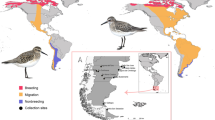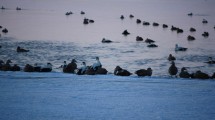Summary
The seasonal and long-term population dynamics of helminths parasitizing voles suggested that density-dependent factors might be important in the population dynamics of common species, whereas density-independent factors predominate in the regulation of the rare species. To test this, we used single and multiple regression to analyse the effects of climatic factors and host density on populations of six species of vole helminths over 12 years. The data do support the idea of a difference between common and rare species of helminths, but they clearly do not support the above hypothesis. The common helminths Heligmosomum mixtum (Nematoda) and Catenotaenia sp. (Cestoda) responded to changes in temperature sum (>5° C days) and precipitation during summer. The combined effect of climatic factors and host density explained most of the variation in the long-term dynamics of these common species. By contrast, the long-term dynamics of the rare helminths Paranoplocephala kalelai (Cestoda), Mastophorus muris, Capillaria sp. and Syphacia petrusewiczi (Nematoda) were explained less well by weather and host density than those of the common ones. Furthermore, the common and rare helminths differed in some ways in their responses to climatic factors.
Similar content being viewed by others
References
Andersen FL, Levine ND (1968) Effect of desiccation on survival of the free-living stages of Trichostrongylus colubriformis. J Parasitol 54: 117–128
Callinan APL (1979) The ecology of the free-living stages of Trichostrongylus vitrinus. Int J Parasitol 9: 133–136
De Chaneet GC, Dunsmore JD (1988) Climate and the distribution of intestinal Trichostrongylus spp. of sheep. Vet Parasitol 26: 273–283
Genov T (1984) Helminths of insectivorous mammals and rodents in Bulgaria (in Bulgarian). Publishing house of the Bulgarian Academy of Sciences, Sofia, p 348
Gleason LN, Buckner RL (1979) Oribatid mites as intermediate hosts of certain anoplocephalid cestodes. Transact Kentucky Acad Sci 40: 27–32
Hansson L, Henttonen H (1985) Gradients in density variations of small rodents: the importance of latitude and snow cover. Oecologia 67: 394–402
Haukisalmi V (1986) Frequency distributions of helminths in microtine rodents in Finnish Lapland. Ann Zool Fennici 23: 141–150
Haukisalmi V, henttonen H, Tenora F (1987) Parasitism by helminths in the grey-sided vole (Clethrionomys rufocanus) in northern Finland: influence of density, habitat and sex of the host. J Wildl Dis 23: 233–241
Haukisalmi V, Henttonen H, Tenora F (1988) Population dynamics of common and rare helminths in cyclic vole populations. J Anim Ecol 57: 807–825
Henttonen H, Kaikusalo A, Tast J, Viitala J (1977) Interspecific competition between small rodents in subarctic and boreal ecosystems. Oikos 29: 581–590
Henttonen H, Oksanen T, Jortikka A, Haukisalmi V (1987) How much do weasels shape microtine cycles in the northern Fennoscandian taiga? Oikos 50: 353–365
Hudson PJ, Dobson AP, Newborn D (1985) Cyclic and non-cyclic populations of red grouse: a role for parasitism? In: Rollinson D, Anderson RM (eds) Ecology and genetics of host-parasite interactions. Academic Press, London, pp 77–89
Joyeux C, Baer JG (1945) Morphologie, evolution et position systematique de Catenotaenia pusilla (Goeze, 1782), cestode parasite de rongeurs. Rev Suisse Zool 52: 13–51
Kisielewska K (1970) Ecological organization of intestinal helminth groupings in Clethrionomys glareolus (Schreb). (Rodentia). I. Structure and seasonal dynamics of helminth groupings in a host population in the Bialowieza National Park. Acta Par Polonica 18: 121–147
Laws GF (1968) Physical factors influencing survival of taeniid eggs. Exp Parasitol 22: 227–239
Lewis JW (1968) Studies on the helminth parasites of the longtailed field mouse, Apodemus sylvaticus sylvaticus from Wales. J Zool (London) 154: 313–331
Lewis JW (1987) Helminth parasites of British rodents and insectivores. Mammal Rev 17: 81–93
May RM (1981) Models for single populations. In: May RM (ed) Theoretical ecology. Principles and applications. Blackwell Scientific Publications, Oxford, pp 5–29
Myllymäki A, Paasikallio A, Pankakoski E, Kanervo V (1971) Removal experiments on small quadrants as a means of rapid assessment of the abundance of small mammals. Ann Zool Fennici 8: 177–185
Tenora F, Henttonen H, Haukisalmi V (1983) On helminths of rodents in Finland. Ann Zool Fennici 20: 37–45
Tenora F, Haukisalmi V, Henttonen H (1985) Andrya kalelai sp. n. and (?)Anoplocephaloides sp., Cestoda, parasites of Clethrionomys-rodents in Finland. Ann Zool Fennici 22: 411–416
Waller PJ, Donald AD (1970) The response to desiccation of eggs of Trichostrongylus colubriformis and Haemonchus contortus (Nematoda: Trichostrongylidae). Parasitology 61: 195–204
Author information
Authors and Affiliations
Rights and permissions
About this article
Cite this article
Haukisalmi, V., Henttonen, H. The impact of climatic factors and host density on the long-term population dynamics of vole helminths. Oecologia 83, 309–315 (1990). https://doi.org/10.1007/BF00317553
Received:
Accepted:
Issue Date:
DOI: https://doi.org/10.1007/BF00317553




